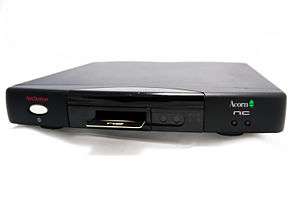Acorn Network Computer
The Acorn Network Computer was a network computer (a type of thin client[1]) designed and manufactured by Acorn Computers Ltd. It was the implementation of the Network Computer Reference Profile that Oracle Corporation commissioned Acorn to specify for network computers (for more detail on the history, see Acorn's Network Computer). Sophie Wilson of Acorn led the effort. It was launched in August 1996.
 Acorn NetStation NC | |
| Developer | Acorn Computers, Oracle |
|---|---|
| Manufacturer | Acorn Computers |
| Release date | August 1996 |
| Discontinued | 2006 |
| Operating system | NCOS on 4096 KB ROM) |
| CPU | ARM 7500FE processor at 40 MHz; approx 35.9 MIPS |
| Memory | 4096 KB 12 MHz RAM |
| Predecessor | Acorn Computer Group |
| Related articles | Acornsoft |
The NCOS operating system used in this first implementation was based on RISC OS and ran on ARM hardware.[2][3] Manufacturing obligations were achieved through a contract with Fujitsu subsidiary D2D.[4]
In 1997, Acorn offered its designs at no cost to licensees of RISC OS.[5]
Hardware models
Original model
The NetStation was available in two versions, one with a modem for home use via a television, and a version with an Ethernet card for use in businesses and schools with VGA monitors and an on-site BSD Unix fileserver based on RiscBSD, an early ARM port of NetBSD. Both versions were upgradable, as the modem and Ethernet cards were replaceable "podules" (Acorn-format Eurocards). The home version was trialled in 1997/98 in conjunction with BT.[6]
The Home NC and Corporate NC both used the ARM 7500FE and supported PAL, NTSC and SVGA displays. They had identical specifications.[7][8] The Office NC used a StrongARM SA-110 200 MHz processor.[9] The ARM7500-based DeskLite was launched in 1998.[10]
StrongARM
Acorn continued to produce ARM-based designs, demonstrating its first StrongARM prototype in May 1996,[11] and the Office NC 6 months later.[12] This evolved into the CoNCord, launched in late 1997.[13][14]
Usage
The NetStation was planned to ship with a smart card to enable internet banking.[16]
See also
References
- Technology and the School Library: A Comprehensive Guide for Media Specialists and Other Educators, Odin L. Jurkowski, Lanham, Md. : Scarecrow Press, 2010, p.31
-
Loosemore, Tom (1996-10-04). "Five Go Nuts in Cambridge". Wired UK. Guardian Media Group/Wired Ventures. pp. 44–47. Archived from the original on 18 May 2011. Retrieved 2011-05-04.
[Ellison's] proposed Network Computer needed things Acorn already possessed in spades: a cheap, powerful processor in the form of the ARM 7500; a compact ROM-based operating system, RISCOS; TV compatibility.
-
"Acorn Group spurs NC clone market by giving away nc hardware production and reference designs". PR Newswire. 1997-08-19. Retrieved 2011-06-07.
A scaled down version of RISC OS was licensed to Oracle to form its NCOS(TM).
-
"Acorn announces immediate availability of Acorn NC". PR Newswire. 1996-11-05. Retrieved 2011-06-07.
In England, Acorn has contracted with D2D, a division of Fujitsu/ICL to manufacture the Acorn NC.
-
"Acorn Group spurs NC clone market by giving away nc hardware production and reference designs". PR Newswire. 1997-08-19. Retrieved 2011-06-07.
Acorn Group has decided to offer its Network Computer hardware production and reference designs at no cost to licensees of its information appliance operating system, RISC OS.
- "Acorn and BT trial consumer NC". ZDNet. June 11, 1997. Retrieved December 15, 2011.
The trial will combine Acorn's NC technology with BT's communications network and will be centred around BT's laboratories in Martlesham, Suffolk. [...] "our aim with this trial is to prove the technology and services over a six month period, ending in March 1998 [...]"
- "Acorn Home NC". Acorn Computers. 1997-06-26. Archived from the original on 1998-02-02. Retrieved 2011-05-18.
- "Acorn Corporate NC". Acorn Computers. 1997-06-12. Archived from the original on 1998-02-02. Retrieved 2011-05-18.
- "Digital's StrongARM Microprocessors Take CPU Lead in Network Client Market". ARM Ltd. 1996-11-13. Archived from the original on 1998-05-12. Retrieved 2011-05-25.
- "Acorn, Boca launch DeskLite thin-client". telecompaper. 8 September 1998. Retrieved 10 March 2014.
-
"Acorn demonstrates first ever StrongARM Network Computer". PR Newswire. 1996-05-20. Retrieved 2011-06-07.
The StrongARM NC prototype [...]
-
"Acorn Computer Group unveils Rrange of new NC devices". PR Newswire. 1996-11-05. Retrieved 2011-06-07.
today demonstrated a variety of network computing devices including the Acorn NC, the Office NC, the Set-top Box NC (STB NC), the ExecPhone NC, and the NC TV.
- Davis, Jim (1997-10-06). "Acorn launches fast home NC". CNET.com. Retrieved 2011-06-10.
[...] one of the fastest set-top boxes today, one with a 233-MHz processor [...] new Concord network computer [...]
- "StrongARM speed captured on the television screen". Times Higher Education. 17 November 1997. Retrieved 10 March 2014.
- "Network computers announced at oracle open world". Telecompaper. Retrieved 2011-06-10.
Acorn Computer Group announced the NC TV, Set-Top-Box NC, ExecPhone, and Office devices [...]
- Clark, Etelka (March 19, 1997). "Banking on it". Personal Computer World. Retrieved April 10, 2012.